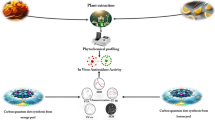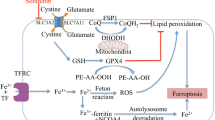Abstract
In the present investigation we report that the natural antioxidant green tea polyphenols (GTPs) could induce apoptosis in HeLa cells in the presence of copper cation. After treatment with low concentrations of GTP (5-15 μM) plus 2 μM Cu2+, HeLa cells died gradually as measured by the MTT assay. Agarose gel electrophoresis analysis of DNA extracted from HeLa cells exposed to GTP/Cu2+ showed typical internucleosomal DNA fragmentation (DNA ladder), which was also confirmed by DNA content analysis by flow cytometry. Morphological observation of HeLa cells treated with GTP/Cu2+ by transmission electronic microscopy also showed typical apoptotic features including cell shrinkage, chromatin condensation, and the formation of apoptotic bodies. Laser confocal microscopy determination of intracellular calcium level revealed that exposure to GTP/Cu2+ triggered increase of cytosolic calcium ion, which may be involved in the process of apoptosis. This evidence suggested that GTPs might be used as potential therapeutic agent for the treatment of cancer.
Similar content being viewed by others
REFERENCES
C. B. Thompson, Apoptosis in the pathogenesis and treatment of disease, Science 267, 1456-1462 (1995).
B. L. Zhao, X. J. Li, R. G. He, S. J. Cheng and W. J. Xin, Scavenging effect of extracts of green tea and natural antioxidants on active oxygen radicals, Cell Biophys. 14, 179-185 (1989).
Q. Guo, B. L. Zhao, M. F. Li, S. R. Shen and W. J. Xin, Studies on protective mechanisms of four components of green tea polyphenols against lipid peroxidation in synaptosomes, Biochim. Biophys.Acta 1304, 210-222 (1996).
Q. Guo, B. L. Zhao, S. R. Shen, J. W. Hou, J. G. Hu and W. J. Xin, ESR study on the structure-antioxidant activity relationshipof tea catechins and their epimers, Biochim.Biophys.Acta 1427, 13-23 (1999).
F.-J. Yang, B-L. Zhao and W.-J. Xin, Studies on toxicological mechanisms of gas-phase cigarette smoke and protective effects of GTP, Res.Chem.Interm. 17, 39 (1992).
C. Han, Screening of anticarcinogenic ingredients in tea polyphenols, Cancer Lett. 114, 153-158 (1997).
J. Jankum, S. H. Selman, R. Swiercz and E. Skizypczak-Jankum, Why drinking green tea could prevent cancer, Nature 387, 561 (1997).
Y. Cao and R. Cao, Angiogenesis inhibited by drinking tea, Nature 398, 381 (1999).
W. Li, Q. Guo, B. L. Zhao, S. R. Shen, J. W. Hou and W. J. Xin, ESR spectroscopy structural analysis of the semiquinone free radicals of green tea polyphenols and their components, Chin. J.Mag.Reson. 15, 507-513 (1999).
M. B. Hansen, S. E. Nielsen and K. Berg, Re-examination and further devopment of a precise and rapid dye method for measuring cell growth/ cell kill, J.Immunol.Methods 119, 203-210 (1989).
J. A. Watt, C. J. Pike, A. J. Walencewicz-Wasserman and C. W. Cotman, Ultrastructural analysis of β-amyloid-induced apoptosis in cultured hippocampal neurons, Brain Res. 661, 147-156 (1994).
M. Didier, S. Bursztajn, E. Adamec, L. Passani, R. A. Nixon, J. T. Coyle, J. Y. Wei and S. A. Berman, DNA strand breaks induced by sustained glutamate excitotoxicity in primary neuronal cultures, J.Neurosci. 16, 2238-2250 (1996).
Y. C. Ni, B. L. Zhao, J. W. Hou and W. J. Xin, Preventive effect of Ginkgo biloba extract on apoptosis in rat cerebellar neuronal cells induced by hydroxyl radicals, Neurosci.Lett. 214, 115-118 (1996).
O. Sachiko, S. Masami, H. Moriaki, S. Eisaburo, K. Atsumasa and F. I-Erota, Mechanisms of growth inhibition of human lung cancer cell line, PC-9, by tea polyphenols, Jpn.J.Cancer Res. 88, 639-643 (1997).
H. Jacobi, B. Eicke and I. Witte, DNA strand break induction and enhanced cytotoxicity of propyl gallate in the presence of copper(II), Free Radicals Biol.Med. 24, 972-978 (1998).
H. Jacobi, M.-L. Hinrichsen, D. Web and I. Witte, Induction of lipid peroxidation in human fibroblasts by the antioxidant propyl gallate in combination with copper(II), Toxicol.Lett. 110, 183-190 (1999).
S. A. Lipton and P. Nicotera, Calcium, free radicals and excitotoxins in neuronal apoptosis, Cell Calcium 23, 165-171 (1998).
Rights and permissions
About this article
Cite this article
Li, W., Wei, T., Xin, W. et al. Green tea polyphenols in combination with copper(II) induce apoptosis in HeLa cells. Research on Chemical Intermediates 28, 585–594 (2002). https://doi.org/10.1163/15685670260373344
Issue Date:
DOI: https://doi.org/10.1163/15685670260373344




